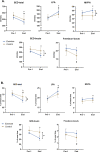Reliability of the accelerometer to control the effects of physical activity in older adults
- PMID: 36095032
- PMCID: PMC9467325
- DOI: 10.1371/journal.pone.0274442
Reliability of the accelerometer to control the effects of physical activity in older adults
Abstract
Background: Reliable physical activity measurements in community-dwelling older adults are important to determine effects of targeted health promotion interventions. Many exercise interventions aim to improve time spent sedentary (SED), in light-intensity-physical-activity (LPA) and moderate-to-vigorous-intensity-physical-activity (MVPA), since these parameters have independently proposed associations with health and longevity. However, many previous studies rely on self-reports which have lower validity compared to accelerometer measured physical activity patterns. In addition, separating intervention-effects from reactivity measurements requires sufficient test-retest reliability for accelerometer assessments, which is lacking in older adults.
Objectives: The study objective was to investigate the reliability of sensor-based PA-patterns in community-dwelling older adults. Furthermore, to investigate change over time of physical activity patterns and examine any compensatory-effect from the eight-week supervised exercise-intervention.
Methods: An exercise-group (n = 78, age-range:65-91yrs) performed two 1h-exercise sessions/week during eight-weeks. PA-pattern was assessed (using hip-worn accelerometers), twice before and once during the last-week of the intervention. A control-group (n = 43, age-range:65-88yrs) performed one pre-test and the end-test with no exercise-intervention. A dependent-t-test, mean-difference (95%-CI), limits-of-agreement and intraclass-correlation-coefficient-ICC were used between the two pre-tests. Repeated-measures-ANOVA were used to analyze any intervention-effects.
Results: The exercise-groups´ two pre-tests showed generally no systematic change in any PA- or SED-parameter (ICC ranged 0.75-0.90). Compared to the control group, the exercise intervention significantly (time x group-interaction, p<0.05) increased total-PA-cpm (exercise-group/control-group +17%/+7%) and MVPA-min/week (+41/-2min) and decreased %-of-wear-time for SED-total (-4.7%/-2.7%) and SED-bouts (-5.7%/-1.8%), and SED-bouts min/d (-46/-16min). At baseline level, no significant differences were found between the two groups for any parameter.
Conclusions: The current study presents a good test-retest-reliability of sensor-based-one-week-assessed-PA-pattern in older-adults. Participating in an 8-week supervised exercise intervention improved some physical activity and sedentary parameters compared to the control group. No compensatory-effect was noted in the intervention-group i.e., no decrease in any PA-parameter or increase in SED at End-test (in %-of-wear-time, min/day or total-PA).
Conflict of interest statement
The authors have declared that no competing interests exist.
Figures


References
-
- Bull FC, Al-Ansari SS, Biddle S, Borodulin K, Buman MP, Cardon G, et al.. World Health Organization 2020 guidelines on physical activity and sedentary behaviour. Br J Sports Med. 2020;54(24):1451–62. Epub 2020/11/27. doi: 10.1136/bjsports-2020-102955 ; PubMed Central PMCID: PMC7719906. - DOI - PMC - PubMed
-
- Ekelund U, Steene-Johannessen J, Brown WJ, Fagerland MW, Owen N, Powell KE, et al.. Does physical activity attenuate, or even eliminate, the detrimental association of sitting time with mortality? A harmonised meta-analysis of data from more than 1 million men and women. The Lancet. 2016;388(10051):1302–10. doi: 10.1016/S0140-6736(16)30370-1 - DOI - PubMed
-
- Lee IM, Shiroma EJ, Lobelo F, Puska P, Blair SN, Katzmarzyk PT, et al.. Effect of physical inactivity on major non-communicable diseases worldwide: an analysis of burden of disease and life expectancy. Lancet. 2012;380(9838):219–29. Epub 2012/07/24. doi: 10.1016/S0140-6736(12)61031-9 ; PubMed Central PMCID: PMC3645500. - DOI - PMC - PubMed
MeSH terms
LinkOut - more resources
Full Text Sources
Medical
Miscellaneous

